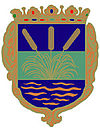Our town

With its 1,924 inhabitants, the Free City of Rust is the smallest administrative district in Austria. Due to the fact that Rust is a statutory town, the affairs of the municipal administration of the town itself are handled by the Municipality of the Free City of Rust. This is located in the town hall, Conradplatz 1. The mayor thus also performs the function of a district administrator. Therefore, passports can be issued, businesses can be registered and much more can be done in the town hall.
The reasons for giving the town rights to Rust are historical. As early as 1681, when Burgenland still belonged to Hungary, the citizens of Rust were granted town rights. After the annexation of Burgenland to Austria, the two Hungarian “royal free cities” Eisenstadt and Rust became Austrian statutory cities – the name Free City was retained. If an Austrian city were to apply for its own city charter today, it would have to have at least 20,000 inhabitants. This information is also evidence of the exceptional status granted to the “royal free city” of Rust and its 1,924 inhabitants in the Austrian constitution.
In any case, the Free City of Rust and its citizens are proud to occupy this exceptional position
Historic town centre
The entire area of the historic center of Rust is a protected monument and is considered one of the most picturesque structures of its kind. The many old town houses from the 16th to 19th centuries have well-kept Baroque or Renaissance facades with beautiful window and portal surrounds, arched fronts, coat of arms and stucco decorations. The town center covers an area of about 9 hectares and is inhabited by 320 citizens of Rust.
The historical town center is protected by the “Hague Convention for the Protection of Cultural Property in the Event of Armed Conflict”. Blue and white signs mark the individual objects.
The “royal free city” of Rust was chosen in 1975 by the Commissioner of the Council of Europe in Strasbourg to become one of the model cities for the European Year of Architectural Heritage, along with Salzburg and Krems, and it was a conscious decision to select a small town where, unlike many other historic cities, there were no residential areas in danger of falling into disrepair. Rust was chosen because it is a vital town, not a revitalized one. The houses still have their original function as residential or commercial buildings of the citizens of Rust.
In 2001, the old town of Rust, together with the Fertö- to/Neusiedler See region, was included in the list of UNESCO World Heritage Sites.
Rust has been awarded the title of “Most Beautiful Town in Burgenland” several times for the measures taken to preserve its historic buildings and culture.
statistics
Inhabitants: (01.01.2015)
1931 Main residences
796 Secondary residence
Surface area: 20.01 km²
Altitude: 123 m
Municipal code: 10201
Administrative district: Rust
Legal district: Eisenstadt

